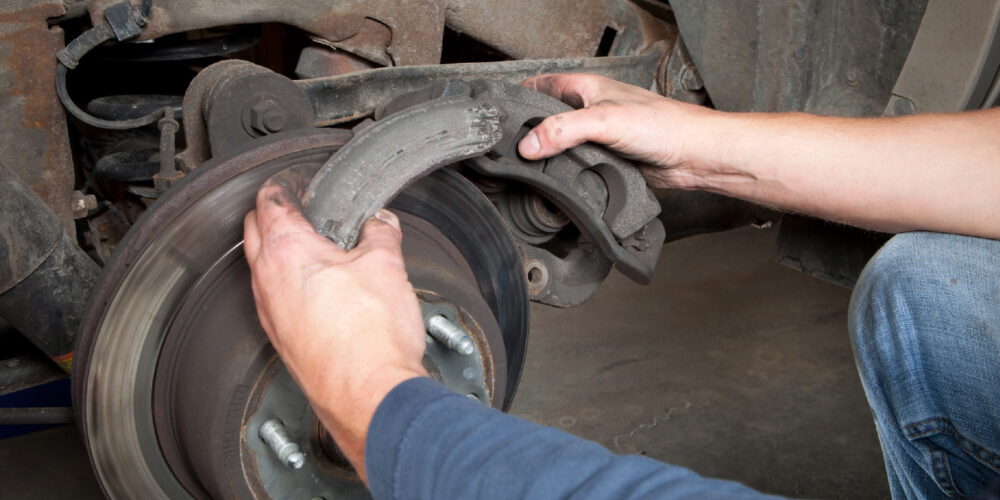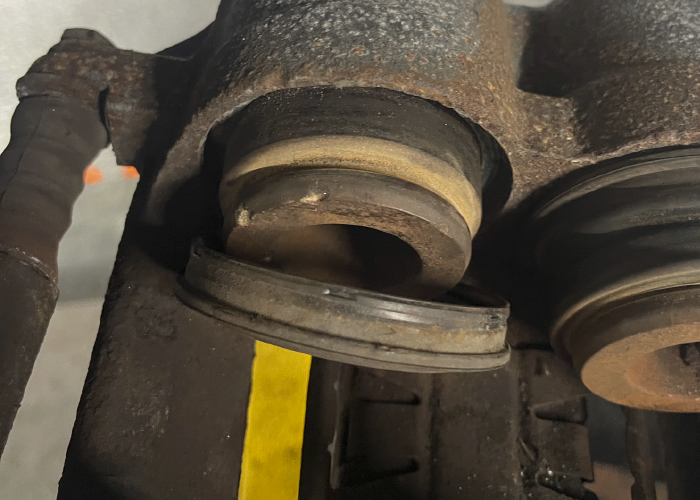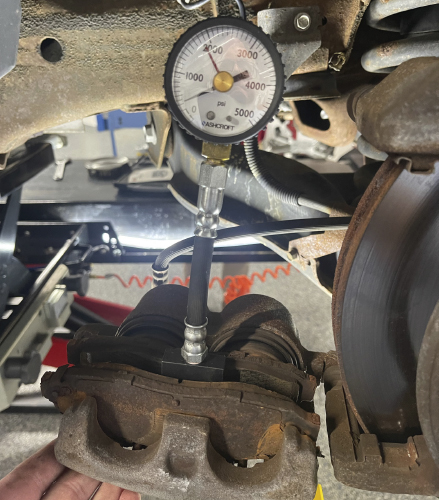A brake pull can be a simple repair or an exercise in frustration if the cause is not methodically diagnosed. Oftentimes, a shotgun approach results in parts being replaced needlessly in search of a cure. A methodical diagnostic routine will save time, parts, money and customers.
Let’s start with a few tips when diagnosing brake pull during a test drive. Don’t forget to check the simplest, most obvious thing: tire inflation pressure or mismatched tire sizes. These can cause a constant pull or one that’s most noticeable during braking. Try swapping tires from side to side, as a bad tire can also cause a pull.
Keep in mind that pulls during braking can come from the front brakes, rear brakes, or sometimes, not from the brakes at all! Loose or worn steering or suspension components can also cause a pull. A steering wheel that changes relative positions during straight-ahead driving after braking is a tip-off that something is loose in the suspension or steering, causing a drastic toe change.
Remember that a stuck caliper also can cause a pull, even when the brakes are not applied. Drive the car and note the severity of the pull. Stop at a safe place and really step down hard on the brake pedal. Drive again, and if the pull is worse, a stuck piston is the most likely problem. Walk around the car and compare the heat emanating from each wheel. A non-contact infrared thermometer can be a big help here. If one wheel is obviously hotter, you’ve found a brake problem, not a suspension or steering problem.
The Hose Effect
An often-misdiagnosed cause of pull is a collapsed brake hose. The hose will look OK on the outside, but the inner liner will cause a restriction on the inside. A brake hose problem like this can take two forms. First, it can act like a restrictor in the line. Second, it can act like a check valve.
In the first case, the car will pull to the side with the good brake hose upon initial application of the brakes, but after a second or two, the pull goes away. Because the caliper needs a relatively large volume of fluid to move the piston, the side with the collapsed hose will apply later than the one with the good hose. This is because it takes longer to get enough fluid volume into the caliper to move the brake pad against the rotor. This is why the pull can be extreme on the initial pedal application, but goes away as the fluid slowly moves the piston.
In the “check valve” situation, fluid will freely flow into the caliper, but will not return to the master cylinder. This can mimic a stuck piston, as the caliper will fail to release fully.
Symptom Diagnostics
When you return to the shop, start looking for the cause of the problem. If you find a hot brake, look there first. The heat indicates friction, and you must find out why. Remember that the hot brake is not necessarily the problem side. For example, if the right front caliper is stuck and not applying, it will be cool and the left front hot. The vehicle will also pull to the left.
Compare how easily the dragging wheel spins compared to the opposite side by turning it by hand. If it’s difficult to turn, loosen the bleeder screw. If the wheel turns freely after relieving the pressure in the caliper, the caliper is OK. If only one wheel is affected, it’s probably the brake hose. To be sure it’s not something upstream, reapply the brakes and release, then loosen the hose at the fitting on the body (not at the caliper). If the problem goes away, the hose is in good condition. Look at the proportioning valve, master cylinder or ABS system.
If loosening the bleeder screw does not allow the wheel to turn freely, you need to investigate the caliper. It may be that the piston is seized in the bore of the caliper, or maybe the mounting hardware is preventing the caliper from releasing the outboard pad (if the caliper is a typical single-piston floating design). Sometimes a tip-off here is the relative thickness of the pads. If the outer pad is worn more than the inner pad, the caliper hardware is the most likely cause. In either event, remove the caliper from the knuckle. Check for seizing or binding of the caliper mounting hardware.
Open the bleeder screw and attempt to push the piston back into its bore as when replacing brake pads. The piston should easily push fully into the bore throughout its entire stroke. If it sticks, replace or rebuild the caliper. If the hardware is corroded or seized, repair or replace as necessary.
Gauging Your Work
When diagnosing a pull due to uneven hydraulic pressure, a pair of brake pressure gauges can come in handy for comparing pressures side to side. They tee into the brake lines and can be used to directly measure hydraulic pressure.
Since they can be installed almost anywhere in the brake system, they’re particularly convenient for checking ABS hydraulic units, master cylinders and proportioning valves. Many OEMs actually have brake pressure specs for checking front versus rear pressure when diagnosing proportioning valves. Gauges are also available with “pads” that can be inserted in place of the brake pad of the vehicle. The actual force applied to the pad can be checked and compared side to side to help find mechanical problems with the caliper in addition to hydraulic ones.
When using pressure gauges, it’s best to have an assistant depress the brake pedal while you observe the gauges. You want to look not only at the maximum pressure of each wheel, but also the “rise time” or the time that it takes to reach that pressure. A restricted brake hose will cause the pressure to build more slowly than a free-flowing hose. A restriction will also cause the pressure to drop slowly when the brake is released. Remember, too, that a dented metal brake line can cause the same slow response as a defective brake hose. Since it is compressible, air in one brake line can also reduce pressure. When in doubt, bleed the system.
Common Component Quandaries
Sometimes the caliper hardware will be loose instead of seized. This can cause the affected brake to apply unevenly, resulting in a pull condition.
A similar condition can arise when a worn or misadjusted wheel bearing causes the brake rotor to not be in the same plane as the caliper and brake pads. Don’t overlook the wheel bearings. Be sure that the caliper is not out of alignment with the rotor. This can sometimes happen if the caliper mounting points (ears of the knuckle or caliper carrier) are bent due to collision damage.
Another possible cause of brake pull is mismatched friction material. There is a big difference in the coefficient of friction between organic lining and semi-metallic lining, for example. There can even be a difference between linings of the same type. Mismatched linings can occur when a do-it-yourselfer replaces pads on just one side. Another possibility is replacing just one “loaded” caliper. Since the pads come with the caliper, calipers should be replaced in pairs to ensure matching friction material.
Brake linings can also be the source of a pull if they become contaminated with grease, oil, brake fluid, etc. Simply cleaning the pads will not rid the lining of contaminant, as it will tend to absorb into the lining like a sponge. Contaminated lining should always be replaced after the source of the contamination is determined and repaired. A glazed or hard-spotted drum or rotor can also alter the coefficient of friction.
Don’t overlook the possibility that worn upper strut mounts are causing a memory steer condition. This is a condition where excessive friction in the steering or suspension system causes the steering to not want to return to the center. Typically, caster will cause the steering wheel to self-center after a turn. If there is too much resistance to the centering force that caster provides, the steering may not fully return to the center.
Worn strut mounts can cause this friction. If they are severely worn, the suspension spring can actually “wind up.” If this happens, the steering may want to return to the side that you last steered it, even if you manually bring the steering wheel back to the center. Hence, the name “memory steer.” Tightening a rubber-filled tie rod end with the steering gear not centered can also cause memory steer as the rubber tries to return to its most relaxed position.
Appropriate Alignment
While misaligned wheels will often cause a constant pull, braking can aggravate a slight pull. An uneven scrub radius can cause a severe pull under braking. The scrub radius is determined as follows: mark a point where the steering axis touches the ground. Mark a point where the center of the tire contact patch touches the ground. The difference between those two points is the scrub radius. If the SAI touches the ground inboard of the tire centerline, the scrub radius is positive. Conversely, if it’s outboard, the scrub radius is negative.
A zero-scrub radius will have little effect on steering pull if one front brake works harder than the other does. A positive scrub radius will pull very hard, while a negative scrub radius will have a minimal effect. (That’s why most all FWD vehicles have zero or a negative scrub radius; to reduce the opposite of brake pull, namely, torque steer.) If the scrub radii of both front wheels are near equal, they will, in effect, cancel each other.
The problem arises when there is a difference between the two. This can happen with bent front suspension components (measure camber, SAI and included angles), wheels with different offsets, or missing spacers on aftermarket wheels. Take note, cars with zero or little scrub radius can have a severely stuck caliper while exhibiting very little pull. Look for signs of uneven pad wear or uneven amounts of brake dust on the wheel and uneven temperatures.
Watch It!
Finally, some technicians pinch off brake hose with vice grips or other tools to prevent the flow of brake fluid to specific components for diagnostic purposes. While this works, be advised that this can permanently damage the hose, collapse the inner liner and create a new problem that only adds mystery to the diagnosis. If you must block off a line, buy or fabricate some block-off plugs from short lengths of tubing with the correct fitting on the end.
















